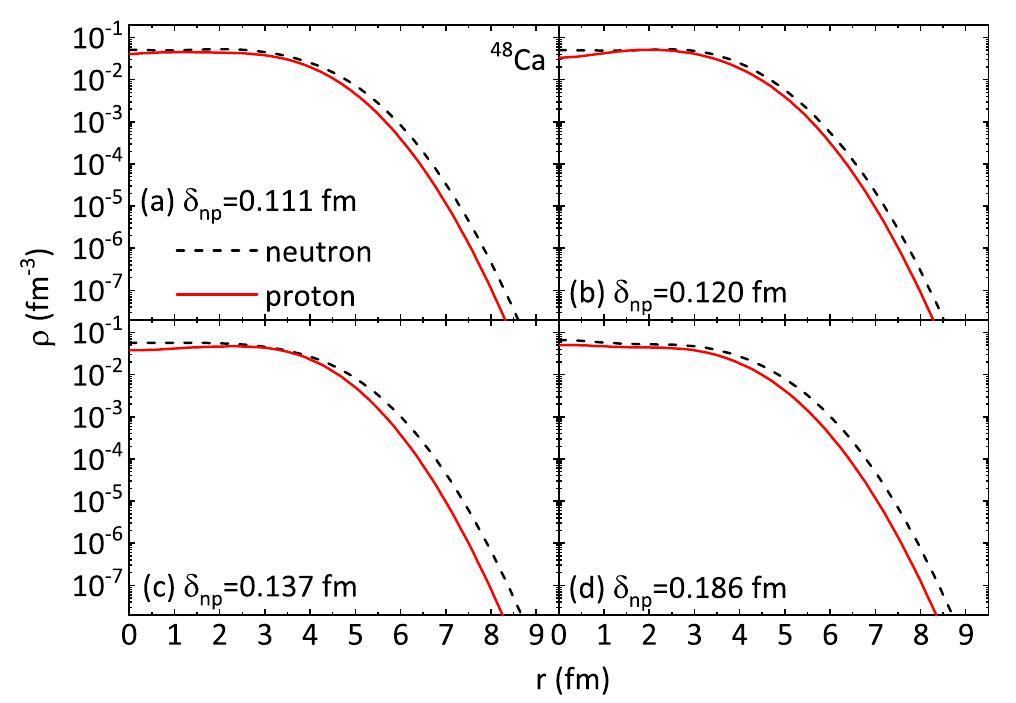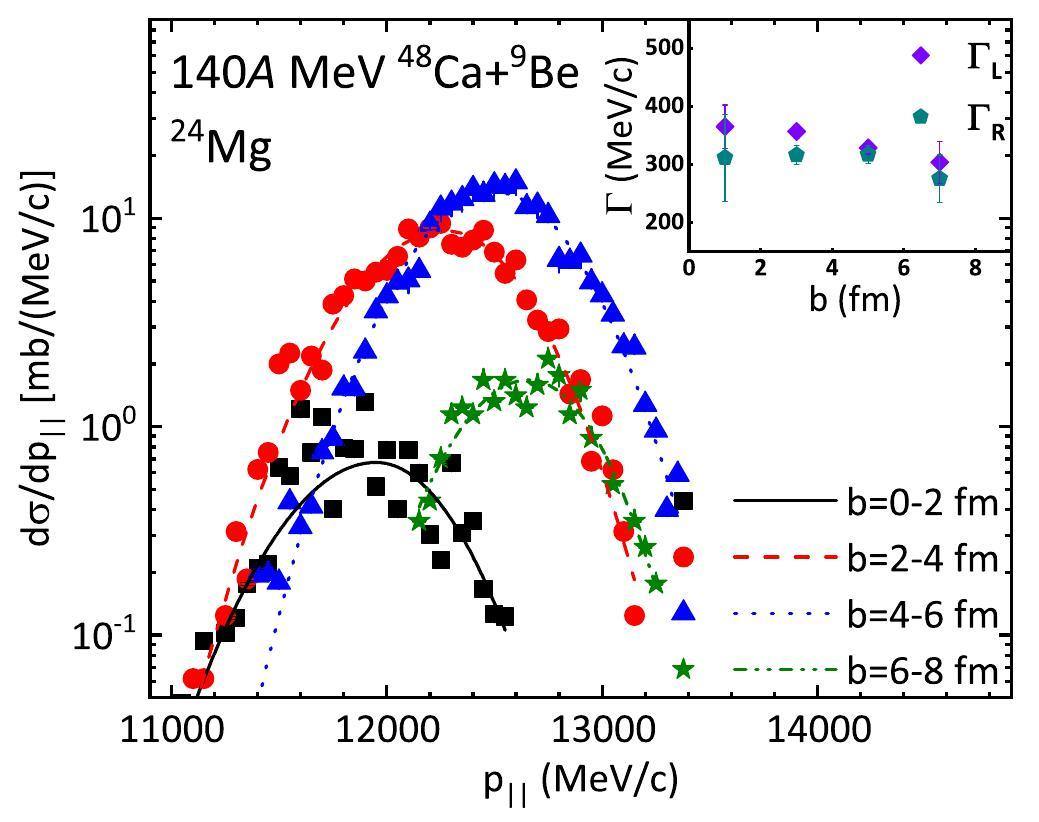INTRODUCTION
The neutron skin thickness, defined as the difference between the root mean square of the neutron and proton density distributions of a nucleus
Model Description
The LQMD model
The LQMD model is an isospin- and momentum-dependent transport model that includes all possible elastic and inelastic collision reaction channels during charge exchange. The temporal evolution of nucleons, hyperons, and mesons in a reaction system under a self-consistently generated mean field is governed by Hamilton’s equations of motion [32-35]. Based on the Skyrme interactions, isospin-, density-, and momentum-dependent Hamiltonians were constructed [34]. The Hamiltonian of baryons consists of the relativistic energy, effective interaction potential, and momentum-related components.
Umom takes the form
During the initialization of the projectile nucleus in LQMD, the initial coordinates of the nucleons are obtained by random sampling according to the two-parameter Fermi-type density distribution [38]:

Parallel momentum distribution
The
Results and discussion

With the varying impact parameters in projectile fragmentation reactions, the

Finally, the

Based on the eikonal distorted-wave impulse approximation (DWIA) explanation by Ogata et al. [30], the high-momentum side reflects the phase-volume effect owing to energy and momentum conservation, whereas the low-momentum side reflects the momentum shift caused by the attractive potential of the residual nucleus when the incident energy is not very high (below 200A MeV). Because the impact parameters are restricted to b= [6–8] fm, the width of ΓL reflects the Heisenberg uncertainty principle in quantum mechanism; that is, from

Summary
In summary, a possible probe for the neutron skin thickness of a neutron-rich projectile nucleus was studied by simulating the 140A MeV 48Ca + 9Be reaction in the framework of the LQMD model. The neutron skin thickness of 48Ca was adjusted by varying the diffuseness of the neutron density distributions. A combined Gaussian function with different widths of the left (ΓL) and right (ΓR) halves was employed to fit
Nuclear fragments in projectile fragmentation reactions
. Prog. Part. Nucl. Phys. 121, 103911 (2021). https://doi.org/10.1016/j.ppnp.2021.103911Multiple-models predictions for drip line nuclides in projectile fragmentation of 40, 48Ca, 58, 64Ni, and 78,86Kr at 140 MeV/u
. Nucl. Sci. Tech. 33, 155 (2022). https://doi.org/10.1007/s41365-022-01137-4Isospin effects on intermediate mass fragments at intermediate energy-heavy ion collisions
. Nucl. Sci. Tech. 33, 58 (2022). https://doi.org/10.1007/s41365-022-01050-wBayesian inference of the crust-core transition density via the neutron-star radius and neutron-skin thickness data
. Nucl. Sci. Tech. 34, 91 (2023). https://doi.org/10.1007/s41365-023-01239-7Neutron/proton ratio of nucleon emissions as a probe of neutron skin
. Phys. Lett. B 682, 396 (2010). https://doi.org/10.1016/j.physletb.2009.11.031Neutron skin thickness and its effects in nuclear reactions
. Nucl. Tech. 46, 155 (2023). (in Chinese) https://doi.org/10.11889/j.0253-3219.2023.hjs.46.080016Triton/3He ratio as an observable for neutron-skin thickness
. Phys. Rev. C 89, 014613 (2014). https://doi.org/10.1103/PhysRevC.89.014613Effect of neutron skin thickness on projectile fragmentation
. Phys. Rev. C 91, 034618 (2015). https://doi.org/10.1103/PhysRevC.91.034618Determination of neutron-skin thickness using configurational information entropy
. Nucl. Sci. Tech. 33, 6 (2022). https://doi.org/10.1007/s41365-022-00997-0Configurational information entropy analysis of fragment mass cross distributions to determine the neutron skin thickness of projectile nuclei
. Nucl. Sci. Tech. 33, 111 (2022). https://doi.org/10.1007/s41365-022-01096-wExcitation of the isovector giant dipole resonance by inelastic α scattering and the neutron skin of nuclei
. Phys. Rev. Lett. 66, 1287 (1991). https://doi.org/10.1103/PhysRevLett.66.1287Measurement of neutron-skin thickness in 208Pb by excitation of the GDR via inelastic α-scattering
. Nucl. Phys. A 719, 304c (2003). https://doi.org/10.1016/S0375-9474(03)00937-0Excitation of giant spin-isospin multipole vibrations
. Nucl. Phys. A 369, 258 (1981). https://doi.org/10.1016/0375-9474(81)90019-1Effects of neutron skin thickness in peripheral nuclear reactions
. Chin. Phys. Lett. 28, 102102 (2011). https://doi.org/10.1088/0256-307X/28/10/102102Measurement of the neutron radius of 208Pb through parity violation in electron scattering
. Phys. Rev. Lett. 108, 112502 (2012). https://doi.org/10.1103/PhysRevLett.108.112502(PREX Collaboration), Accurate determination of the neutron skin thickness of 208Pb through parity-violation in electron scattering
. Phys. Rev. Lett. 126, 172502 (2021). https://doi.org/10.1103/PhysRevLett.126.172502(CREX Collaboration), Precision Determination of the Neutral Weak Form Factor of 48Ca
. Phys. Rev. Lett. 129, 042501 (2022). https://doi.org/10.1103/PhysRevLett.129.042501Measurements of interaction cross sections and nuclear radii in the light p-shell region
. Phys. Rev. Lett. 55, 2676 (1985). https://doi.org/10.1103/PhysRevLett.55.2676Momentum distributions of projectile fragments produced in the cold and hot fragmentation of relativistic 136Xe and 197Au projectiles
. Z. Phys. A 346, 43 (1993). https://doi.org/10.1007/BF01290780Sequential decay distortion of Goldhaber model widths for spectator fragments
. Phys. Rev. C 65, 051602 (2002). https://doi.org/10.1103/PhysRevC.65.051602Effects of neutron-skin thickness on light-particle production
. Phys. Rev. C 109, 024616 (2024). https://doi.org/10.1103/PhysRevC.109.024616Nucleon-nucleon correlations, short-lived excitations, and the quarks within
. Rev. Mod. Phys. 89, 045002 (2017). https://doi.org/10.1103/RevModPhys.89.045002Probing high-momentum component in nucleon momentum distribution by neutron-proton bremsstrahlung γ-rays in heavy ion reactions
. Phys. Lett. B 850, 138514 (2024). https://doi.org/10.1016/j.physletb.2024.138514Measurement of the high energy γ-rays from heavy ion reactions using Čerenkov detector
. Nucl. Sci. Tech. 35, 24 (2024). https://doi.org/10.1007/s41365-024-01368-7Parallel momentum distribution of 28Si Fragments from 29P
. Chin. Phys. Lett. 22, 61 (2005). http://iopscience.iop.org/0256-307X/22/1/018Studies on the exotic structure of 23Al
. Chin. Phys. C 32, 34 (2008). http://csnsdoc.ihep.ac.cn/article/id/68c4071e-1596-4366-8926-9446db4e3d07Study of the deformed halo nucleus 31Ne with Glauber model based on microscopic self-consistent structures
. Sci. China Phys. Mech. Astron. 65, 262011 (2022). https://doi.org/10.1007/s11433-022-1894-6Cross section calculations in Glauber model: I. Core plus one-nucleon case
. Comp. Phys. Commun. 151, 369 (2003). https://doi.org/10.1016/S0010-4655(02)00734-8Breakup reactions of the halo nuclei 11Be and 8B
. Phys. Rev. C 54, 3043 (1996). https://doi.org/10.1103/PhysRevC.54.3043Asymmetry of the parallel momentum distribution of (p, pN) reaction residues
. Phys. Rev. C 92, 034616 (2015). https://doi.org/10.1103/PhysRevC.92.034616Projectile fragmentation of 40Ca, 48Ca, 58Ni, and 64Ni at 140 MeV/nucleon
. Phys. Rev. C 74, 054612 (2006). https://doi.org/10.1103/PhysRevC.74.054612Momentum dependence of the symmetry potential and its influence on nuclear reactions
. Phys. Rev. C 84, 024610 (2011). https://doi.org/10.1103/PhysRevC.84.024610Effects of isospin dynamics on neck fragmentation in isotopic nuclear reactions
. Phys. Rev. C 94, 014609 (2016). https://doi.org/10.1103/PhysRevC.94.014609Nuclear in-medium effects and collective flows in heavy-ion collisions at intermediate energies
. Phys. Rev. C 85, 014604 (2012). https://doi.org/10.1103/PhysRevC.85.014604Isospin effect in peripheral heavy-ion collisions at Fermi energies
. Chin. Phys. C 42, 124106 (2018). https://doi.org/10.1088/1674-1137/42/12/124106Nuclear in-medium and isospin effects on subthreshold kaon production in heavy-ion collisions
. Phys. Rev. C 87, 064605 (2013). https://doi.org/10.1103/PhysRevC.87.064605Direct determination of the neutron skin thicknesses in 40,48Ca from proton elastic scattering at Ep= 295 MeV
. arXiv: 1810.11796 (2018). https://doi.org/10.48550/arXiv.1810.11796An update on droplet-model charge distributions
. Nucl. Phys. A 410, 61 (1983). https://doi.org/10.1016/0375-9474(83)90401-3A possible experimental observable for the determination of neutron skin thickness
. Chin. Phys. B 17, 1216 (2008). https://doi.org/10.1088/1674-1056/17/4/011Systematics of complex fragment emission in niobium-induced reactions
. Nucl. Phys. A 483, 371 (1988). https://doi.org/10.1016/0375-9474(88)90542-8Chun-Wang Ma is an editorial board member for Nuclear Science and Techniques and was not involved in the editorial review, or the decision to publish this article. All authors declare that there are no competing interests.


